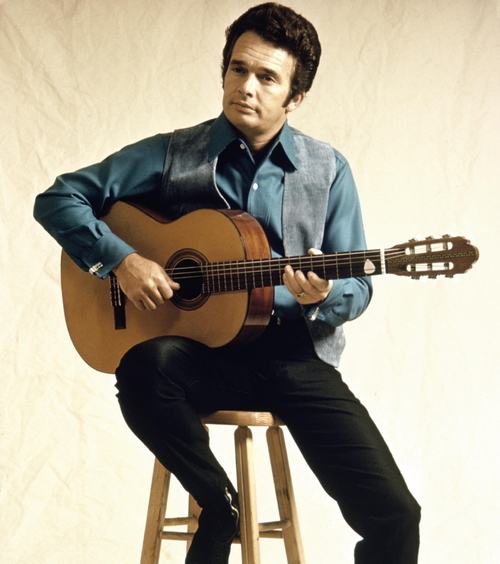
When Merle Haggard died on April 6, 2016, his 79th birthday, the world lost not only one of the greatest country music singer-songwriters in the music’s history, but a true American icon. We are unlikely ever to see another like him.
Haggard was a genuine outlaw in one fashion or another throughout his life and career. A rebellious teen who spent time in juvenile detention facilities, hopped trains, worked odd jobs and was arrested for a variety of offenses, he dreamed of becoming a country singer. His ambitions got a boost when country legend Lefty Frizzell, one of his heroes, let a teenage Haggard perform before his show.
Eventually he began performing in honky-tonks around his hometown of Bakersfield, Calif., and on a local TV show while laboring by day on farms and in oil fields. An attempt to rob a roadhouse landed Haggard in San Quentin Prison in 1958. His continuing rebellious ways finally sent Haggard to solitary confinement. His encounter there with famed death row inmate Caryl Chessman and the execution of a friend he had planned to escape with prompted Haggard to change his ways. A show at the prison by Johnny Cash inspired him to join the prison band. When he was released in 1960, Haggard was determined to make music his life.
Haggard began his national rise as part of a burgeoning Bakersfield scene that included Buck Owens and Wynn Stewart, and eschewed the ever-more-lush Nashville sound for sleek and clean neo-traditional honky-tonk. By 1965 Haggard scored his first national Top 10 hit with “(My Friends Are Gonna Be) Strangers.” Through the rest of the decade, recording for Capitol Records, Haggard established himself as a songwriter of seemingly simple yet profound eloquence with #1 songs he penned like “Mama Tried,” “The Legend of Bonnie and Clyde,” “Hungry Eyes” and “Sing Me Back Home.”
He became known as a spokesman for old-school American values with such hits as “Okie From Muskogee” (1969) – written tongue-in-cheek to amuse his band on the bus between shows – and “The Fightin’ Side of Me” (1970). But Haggard also wrote songs that displayed an almost leftist blue-collar populism. By the late 1960s rockers like The Byrds and The Grateful Dead began performing and recording his songs. He continued to be a leading country chart act through the ’70s, yet balanced his commercial works with tributes to his musical heroes Jimmie Rodgers and Bob Wills. His 1981 autobiography Sing Me Back Home was marked by unflinching honesty about himself. After his successful runs on major labels like Capitol, MCA and Epic, as country music changed and he no longer was played on country radio, he continued to make albums on indie rock and folk labels such as ANTI- and Vanguard.
Over the last quarter-century or so, even though his commercial heyday had passed, Haggard remained a strong concert and large country dancehall draw, having earned an audience that crossed generations and political and cultural divides. He was listened to and admired by rockers and country traditionalists alike, transcending any genre differences to simply become a great American musical artist of the first order.
And throughout it all, Haggard maintained his personal and artistic integrity, making music and living his life by his own firm set of values. “I’ve never been a guy that can do what people told me… It’s always been my nature to fight the system.”
“When we speak of Merle Haggard,” Kris Kristofferson once observed, “we’re not speaking about how he’s going to come out on the Country Music Association awards this year. We’re talking about posterity.”
Haggard lived up to his name: his weather-beaten face, homemade tattoos and sense of pain in his eyes were all testimonials to all the places he had been and things he had seen in his lifetime. His songwriting had a raw solidity as if his compositions were chiseled from hard wood. His rich, warm bell of a voice could be subtly playful, seductive and authoritative, whatever the line or song called for, and few singers could express heartache with such crackling intensity or soothe his listeners’ sorrows with obvious empathy. His band The Strangers was continually country music’s finest live performance outfit, as sharp and sympathetic to their frontman’s needs as Bruce Springsteen’s E Street Band and Tom Petty’s Heartbreakers.
His last album on his own in 2010 was the aptly titled I Am What I Am. Haggard’s most recent recording was 2015’s Django & Jimmie, his sixth collaboration with Willie Nelson.
He had been in ill health in the years before his death, with clogged arteries and lung cancer. He ultimately died from complications of pneumonia.
Haggard’s vast catalog is available in the U.S. here and in the U.K. here. Several books, including his autobiography, are available here.


4 Comments
**HAPPY BIRTHDAY** MERLE…
A Country Legend that is Greatly Missed…
A Beautuful Song of Merle’s to You Tube
is “High On a Hilltop”… Too Many Musical Hits to Mention.. Left a Beautiful Legacy..
“High on a Hilltop” was written and first released by Tommy Collins in the early ’50s. But when Haggard got around to it 12 years later (after Buck Owens released his version) he made it his own, as he did with numerous other Collins’ songs. Tommy Collins is, sadly, highly underappreciated. Haggard, meanwhile, went out on a high note with “Kern River Blues,” one of the strongest singles in his extensive catalog. Sublime. RIP MH and TC & Buck.
merle haggard’s song irma jackson was the first country song about an interracial relationship.
Merle Haggard, was a true blue real American country superstar. He and his real country music will be surely missed. Where are the old country radio stations, to keep this music going?